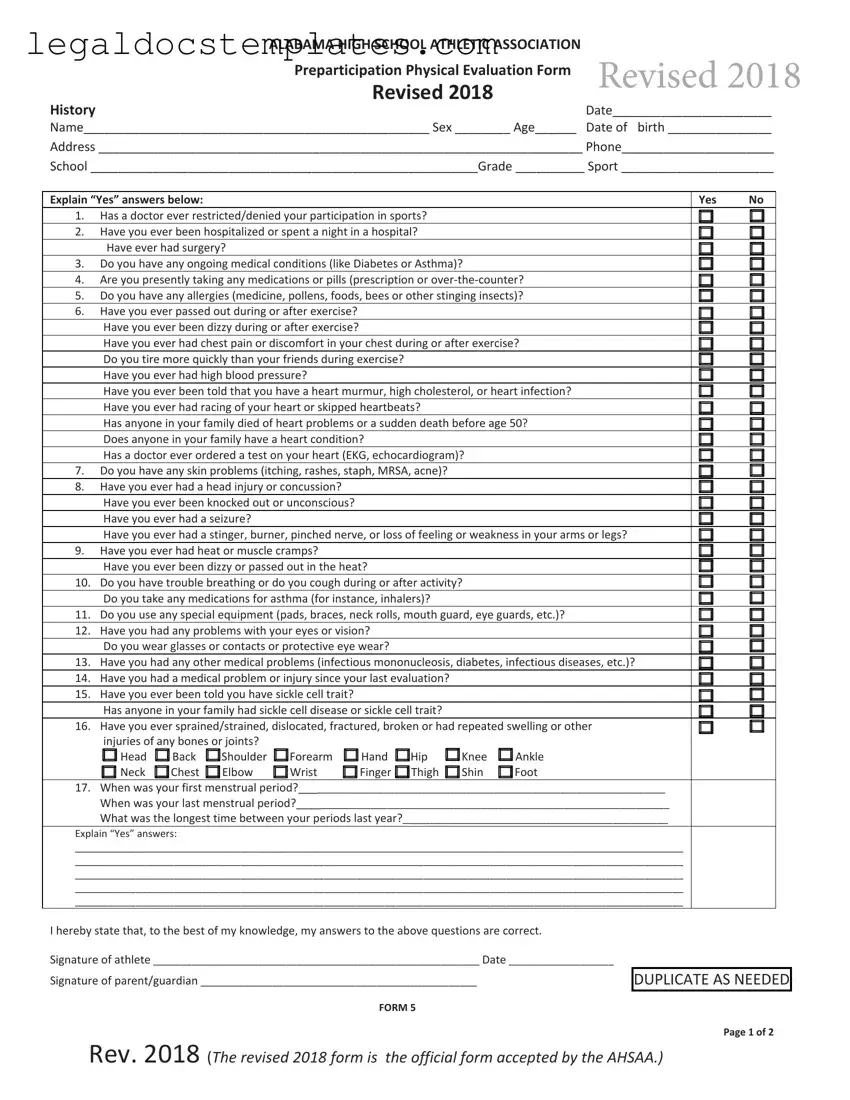The College Sports Preparticipation Physical Evaluation is remarkably similar to the Alabama High School Physical Form. Both documents require current health assessments to certify an athlete's eligibility for participation in sports activities. They demand information on the athlete's medical history, a physical examination, and a physician's clearance indicating the athlete's fitness level. Specific to college-level evaluations, there might be additional focus on cardiovascular assessments due to the increased intensity of college sports.
An Employment Physical Examination Form shares similarities with the Alabama High School Physical Form, particularly in evaluating an individual's physical capability to perform job-related tasks. Both forms include a comprehensive review of personal health history and a physical examination by a licensed healthcare provider. The main difference lies in the purpose: employment exams ensure an employee's capability to perform work duties safely, while the high school form assesses suitability for sports participation.
The Pediatric Well-Visit Form, used during routine child health checks, also bears resemblance to the Alabama High School Physical Form but focuses more on developmental milestones and prevention through immunizations. Both require assessments of physical health, medical history, and current medical conditions. However, the pediatric form is broader, covering growth benchmarks, nutritional assessments, and counseling for age-specific concerns.
A Pre-Surgical Clearance Form, necessary before undergoing surgery, has parallels with the high school physical form in requiring a comprehensive health history review and current health status evaluation. This includes assessments by a physician to establish the patient's readiness and potential risks for surgery. The key difference is the pre-surgical form's focus on mitigating surgical risks, whereas the high school form assesses general physical readiness for sports.
Immigration Physical Examination Forms are akin to the Alabama document in their requirement for a thorough medical examination by an authorized healthcare provider. Both evaluate the individual's health status, vaccination records, and potential for infectious diseases. The immigration form specifically addresses public health concerns for individuals seeking to enter or remain in a country legally.
The Driver's Physical Exam Form, needed for commercial driver's license (CDL) holders, shares similarities with the high school sports physical in assessing an individual’s physical capability to safely perform specific duties; in this case, driving. Both forms examine overall health, vision, hearing, and potential medical conditions that could impair the individual's ability to perform their role safely.
Annual Physical Examination Forms, often used for routine healthcare maintenance, are quite similar to the Alabama High School Physical Form. They both focus on evaluating an individual's health status, including a review of medical history and a physical examination. The annual physical serves a broader purpose of monitoring general health and preventing illness, without the specific context of sports participation.
The Medically Complex Children’s Waiver Evaluation Form parallels the high school physical in assessing a child's medical condition and healthcare needs, particularly those requiring long-term services. While both forms collect comprehensive health information and necessitate a physician's evaluation, the waiver form is specifically designed to assess eligibility for supplementary medical services to support children with complex health issues.
The Work Capability Assessment Form, used to determine an individual’s fitness for work, especially in cases of disability or illness, shares similarities with the high school physical form in its assessment of physical and sometimes mental health conditions. Both require a healthcare professional’s evaluation; however, the work assessment focuses primarily on the individual’s capacity to earn a living despite health constraints.
Finally, the Travel Health Consultation Form, necessary for individuals seeking health advice before traveling internationally, resembles the Alabama High School Physical Form in its method of assessing health to prevent disease. Both require detailed medical history and a health evaluation, though the travel form specifically aims to address and prevent health issues that may arise in specific travel destinations, such as vaccinations and prophylaxis for diseases not common in the traveler's home country.


